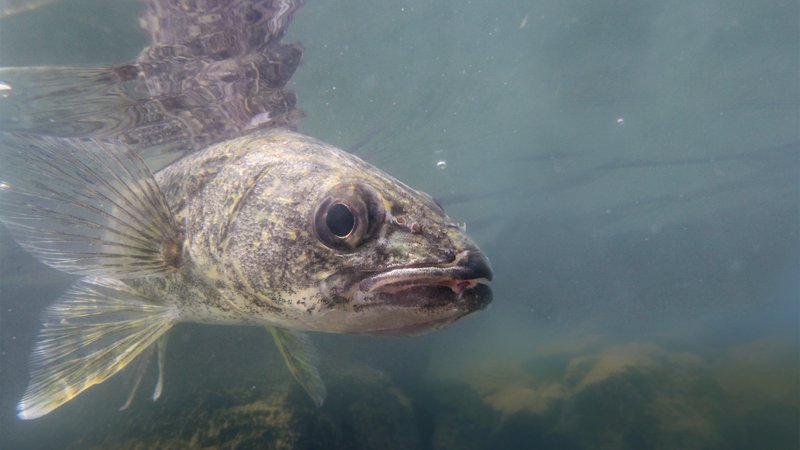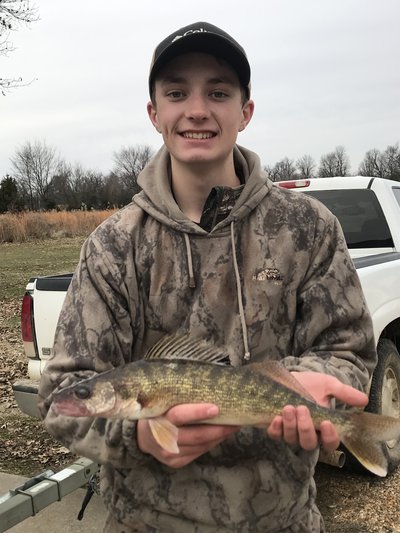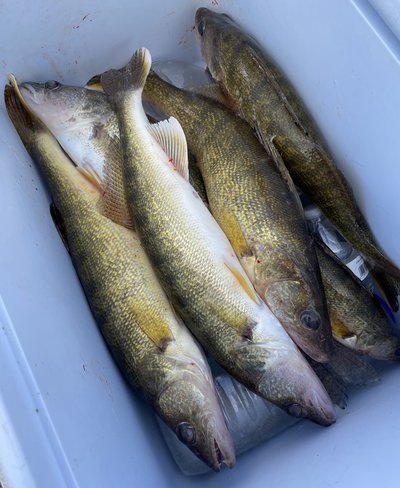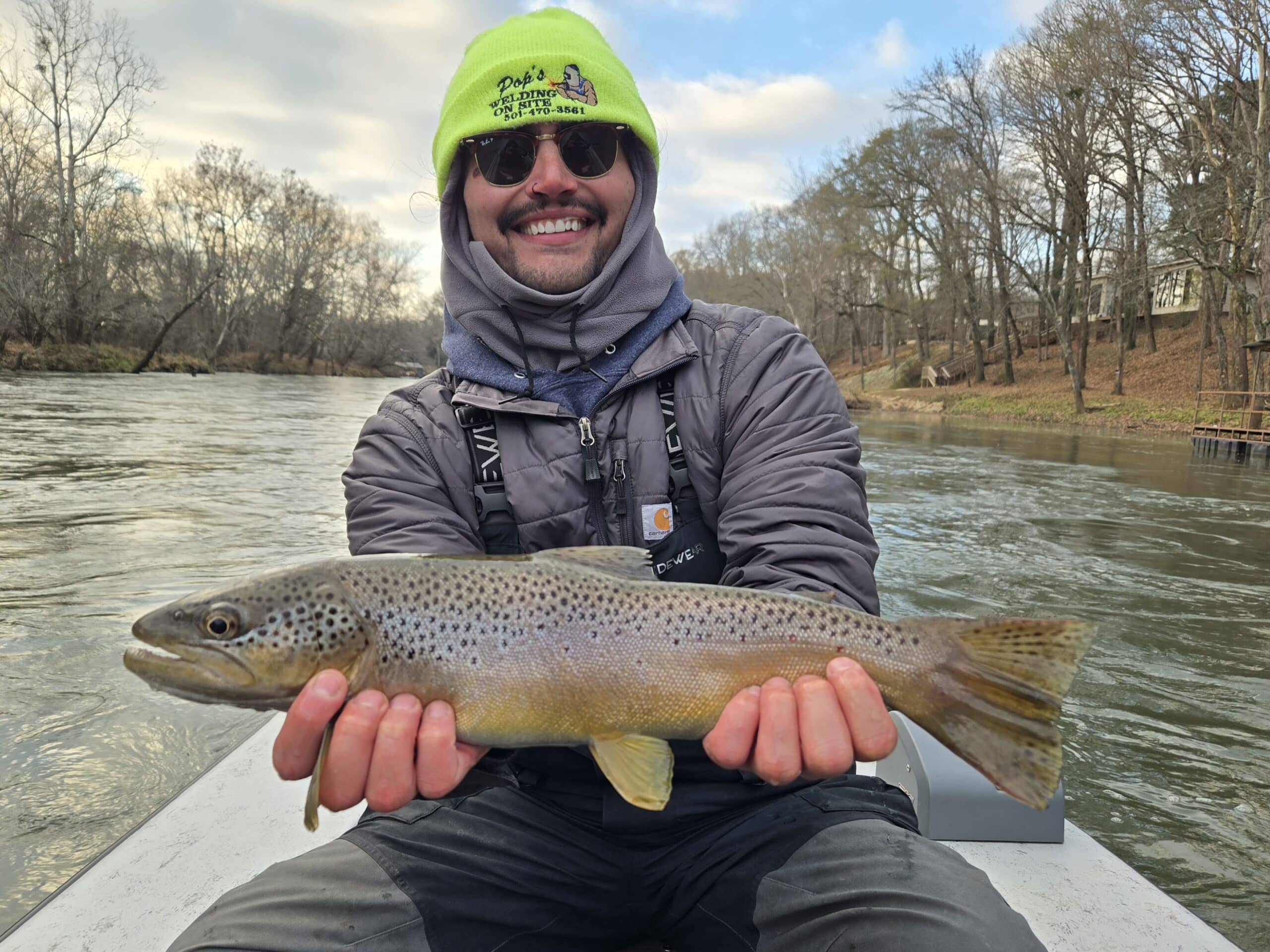Winter walk-in walleye options for Arkansas anglers
ON 02-16-2022

Feb. 16, 2022
Randy Zellers
Assistant Chief of Communications
LITTLE ROCK — Talk to an Arkansas angler about the best-tasting fish, and you’re likely to hear the word “crappie” nine times out of ten. That last response probably will come from someone who’s had the opportunity to fish for walleye and sample what this member of the perch family has to offer at the dinner table.
Walleye are much more streamlined than bass, crappie and other warmwater fish, taking on more of a torpedo shape than that of a football. Their mouths are filled with small peg-like teeth that help them grasp prey and their namesake eyes are equipped with a silvery membrane, called a tapetum lucidum, which helps gather light when these fish are feeding in dark, deep water. Walleye spend most of the year swimming in deep water, but each spring they move shallow to spawn. This is the time when bank anglers can capitalize on the resource and see what all the fuss is about.
Northwest Prospects
Anglers near Rogers and Beaver lake have quite a few options available for walleye fishing, thanks to the White River and War Eagle Creek, which feed the lake. On the upstream end of the White River, Twin Bridges Access at Arkansas Highway 45 can offer an excellent fishing opportunity for shorebound anglers. In addition to launch ramps for boats, kayaks and canoes, the area has plenty of walking space to spread out along the bank and cast.
“Anglers can walk up and down the shoreline and look for rocky shoals to cast to,” Jon Stein, AGFC fisheries supervisor in Northwest Arkansas, said. “The males will move up in early to mid-March, and the fishing is usually at its peak by the third week in March.”
Stein says War Eagle Creek also offers an excellent opportunity for walleye in early spring at a hotspot known as the “Two-dollar hole.”
“The access is just downstream from War Eagle Mill where a landowner offers access for a small fee,” Stein said. “It’s really one of the best locations to access that part of the river by land, so we’re very thankful that the landowner allows access through their property for a small $2 fee at the entrance of their property.
Another hotspot for walleye in the northwest corner of the state is the tailwater below Beaver Dam. While locally known as a trout-fishing hotspot, walleye running upstream from Table Rock Lake will be stopped by the dam, which makes them possible targets for anglers who walk in from below the dam. Beaver Dam Access, Bertrand Access and Houseman Access all offer a place to get to the water by foot, but anglers should be aware that a trout permit is required to fish this section of the White River, even if you’re targeting walleye. A special fishing regulation area also exists for trout in the tailwater which applies to all anglers, and anglers should familiarize themselves with the regulations concerning trout before heading to this walleye-angling option.
Stein also lists the Romp Hole Access on the Kings River as another great destination for walleye anglers.
“Table Rock Lake has a tremendous amount of walleye, and some great spawning areas for that lake are right here in Arkansas,” Stein said. “Spring is the best time to catch them for bank anglers here in the northern half of the state.”
Northeast Nooks
The upper-right corner of the state also is a haven for walleye anglers, but it lacks the large reservoirs found to the west. Its river systems more than make up for that absence when you are talking walleye fishing. The Strawberry, Spring and Eleven Point rivers are hot spots that can’t be overlooked when you are looking to hook into a few spawning walleye. Brett Timmons, regional fisheries supervisor in this corner of the state offered some advice for the shorebound angler looking to cash in on the walleye spawn.
“We have a different strain of walleye here that’s endemic to the Black River,” Timmons said. “It’s a more riverine species that seems to grow better in the delta river systems and is well suited for the habitat here.”
A lot of the walk-in options are dependent on water levels in the rivers, but some of the boat accesses can offer some points to get to the water.
“On the Eleven Point, the boat ramp at Dalton offers some access if the water level is low,” Timmons said. “But this access really shines if someone wanted to do a float trip. They could put in at Dalton and float downstream to the Eleven Point River Access at Highway 62 near Pocahontas.”
On the Strawberry River, Simstown Walk-in Access near Evening Shade is a good spot to check out, as is the Hulett Road Access just north of Poughkeepsie. Hardy Access on the Spring River also offers a good opportunity to fish some of those spawning shoals walleye prefer this time of year.
Greers Ferry Gatherings
Greers Ferry Lake in Heber Springs holds a lofty reputation as one of Arkansas’s top year-round walleye destinations. It was at Greers Ferry that Al Nelson of Higden caught the reigning state-record walleye, a 22-pound, 11-ounce beast that held the world-record spot for the species for some time. But at 31,500 acres, starting the search for walleyes can be a bit daunting. The early spring spawning run is the best time for anglers to find concentrations of these fish and reach them from the bank.
“Stick to the tributaries that feed the lake to capitalize on the spawn,” Matt Schroeder, AGFC fisheries supervisor in Mayflower, said. “There are walk-in opportunities on all of them, depending on the river level. Most of these spots are well known for producing some fish during March.”
On the South Fork of the Little Red River above the lake, the Johnson Hole is a well known access just south of Clinton. On the Middle Fork, a location locally known as Stewart Access is on Schroeder’s top prospects.
“Sandiff Road in Cleburne County runs alongside the access there, and you’ll find a few anglers parking there to walk to the shoals,” Schroeder said. “There’s Ramer Ford off Ramer Ford Road over on the Devil’s Fork of the Little Red that is popular with anglers when the water is at normal pool or slightly lower.”
Schroeder said the peak of the spawn is mostly determined by temperature, and when the water reaches 48 to 50 degrees, you’ll begin to see the fish move into these shallow areas.
“Tom Bly, a long-time fisheries biologist here in Arkansas, always said the length of day also played into the equation, so you would see some of the males begin to show up in late February,” Schroeder said. “The males will show up early and stay late, but the larger females are only there for a short period of time before they leave. But most of the catching occurs before and after the actual peak of the spawn.”
Hot Springs Haunts
Just like the headwaters of Greers Ferry hold shallow shoals where walleye congregate for the spawn, the reservoirs along the Ouachita River hold excellent opportunities to catch walleye in their far upstream ends. Unlike the shoals at Greers Ferry, the best locations for anglers to concentrate along Ouachita River lakes is on the downstream end of the dams separating Lakes Ouachita, Hamilton and Catherine.
“The fish would move upstream to those same sorts of shoals to spawn, but the dams block their upward movement,” Brett Hobbs, AGFC fisheries supervisor in Hot Springs, said. “The walleye will congregate on rocky areas immediately downstream of the dams beginning in late February. Following mid-March, the congregated Walleyes will tend to scatter back downstream and become more elusive and harder for bank anglers to access.”
Excellent walk-in opportunities exist beneath each dam site, and a quick glance on Google Earth will offer directions to River Access at Remmell Dam, Carpenter Dam Park, and Stephens Park Recreation Area just below Blakely Dam.
Traditional wisdom indicates that some of the best fishing occurs within a few hours of sunset, many of the walleye, particularly males, will still hold near spawning areas during the day, especially on overcast days. The larger female fish usually stay a little deeper until they are ready to run up to the shallow water and spawn.
“But only fishing at night is a mistake,” Hobbs said. “There are going to be some fish nearby around the clock.”
What’s on your Line?
All of the biologists agree that the best lures to catch a fish during the spawn will imitate minnows or shad. Anything that can be cranked slowly along the rocks or bounced off bottom will get the walleye’s attention. Curly-tailed grubs on a lead jighead, minnow-imitations like Sassy Shads or small minnow-imitating crankbaits like the Rapala Original Floating Minnow or Storm Thundersticks will produce well when fished along rocky areas.
“If you want to fish live bait, nightcrawlers or minnows suspended under a float will work,” Stein said. “The trick is to find slackwater areas where the current is broken and fish the lure through that. The fish act similar to trout in these streams, sitting in the slack water and waiting for the current to deliver their food so they can save energy.”
Chuck Long, an AGFC regional educator in Northeast Arkansas recently compiled some of his favorite walleye-fishing tips in a Facebook Live video. Click here to take a deep dive into the presentation and learn how to put more ‘eyes on your plate this spring.
Recent News

CWD-positive deer found in Grant, Sevier counties
Dec. 19, 2025

Arkansas Wildlife Weekly Fishing Report
Dec. 18, 2025
Subscribe to Our Weekly Newsletter E-mails
Don’t miss another issue. Sign up now to receive the AGFC Wildlife Weekly Newsletter in your mailbox every Wednesday afternoon (Waterfowl Reports are published weekly during waterfowl season and periodically outside the season). Fishing Reports arrive on Thursdays. Fill in the following fields and hit submit. Thanks, and welcome!
